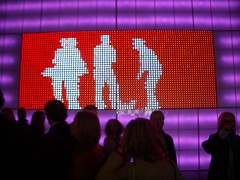The Consumer Electronics Association, which (I'm guessing) sets the agenda for the development of second-generation electronics manufacturers (the ones who are making stuff that was cutting edge last year cheaper this year) has put out a report (400K PDF) which has "hybrid white goods" as a technology to watch. By "to watch" I'm assuming they mean "to make very cheaply." They define the genre by example, which shows how lacking a specific focus makes defining a technology solution difficult:
the new category features such novelties as refrigerators that come with cable-ready TV screens,refrigerators that can monitor the shelflife of your in-box items; ovens that can download and execute recipes via the Internet; and even ovens that can be temperature-controlled during the day so they can store and eventually cook food via a cell phone request while you’re still at the office.
The reasons why people would want this technology are still somewhat unclear: "the prospect of making kitchen chores more efficient [...] will likely be appealing." There's that efficiency argument again, and the solution seems to be...remote controls (that big 1970s new technology hit) for appliances:
Despite the clear benefits, many consumers are intimidated by new technologies[...]
it’s the industry goal to connect all devices to permit remote access.
[...]
Whirlpool,for example, now is testing an upgrade to let Polara owners control their ovens via a cell phone or the Net.
Remote control doesn't seem like a clear benefit to me, but it's interesting to see the marketing gears turning in terms of how it's going to be presented:
“Our research shows that busy consumers still blame themselves when they cannot provide their families with homecooked meals."
Parental guilt + efficiency = remote control. But pressing the guilt button isn't the same thing as giving people something that they're going to embrace for the long term. There needs to be genuine utility. Fortunately, the CEA does recognize this, to some extent:
As a result,consumers may hesitate if the smart kitchen appliance seems more complicated than it needs to be. The industry’s growth could be slowed if companies put the cart in front of the horse.
(and by "complicated" they mean "more work than is justified by the functionality")
John Dvorak makes another interesting point when he says:
The true goal of smart white goods is to get advertising-oriented LCD displays into the home and feed them promotional ads over an IP connection linked from the power lines.
I don't think that the companies are thinking in those terms, it's an awfully 1999 notion, but there's truth to the idea that it's going to be hard to resist cramming as much potentially revenue-generating functionality into the things, possibly at the expense of the user experience. And ads are one that gives companies dollar signs in their eyes, since it seems like free money.
The CEA says: "The industry needs to communicate the benefits in ways that demonstrate how technology makes life simpler and more efficient." However, as long as they're stuck in thinking that it's only simplicity and efficiency that people want, and that all technological functionality needs to stem from, or be crammed into, one of those pidgeon holes, and only guilt that'll get people interested, it's going to be tough to get people to buy. Yes, those are important, but they're only a small proportion of what people want from their household tools. If that's all people were interested in, why would there be so many (labor intensive) espresso makers in the world?
Now that there's an industry-friendly name for the idea and an official blessing, it's much more likely to get funded as part of R&D efforts. I hope they come up with some fuctionality for the technology other than remote-control fridges.
[in related news, iRobot just announced the Scooba a hard floor sibling to their Roomba vacuum cleaner. What's interesting is that these are appliances--white goods--that aren't based on existing white goods, but on much simpler household goods, and they're focused not on remote control, but on work elimination]



















































Recent Comments